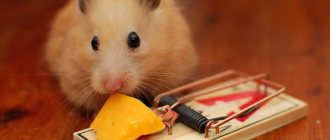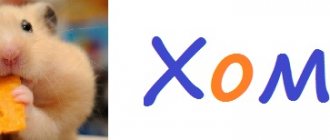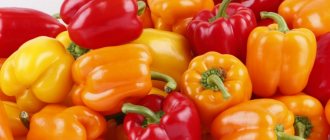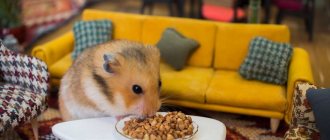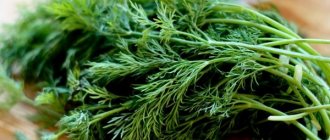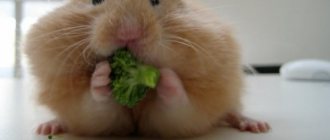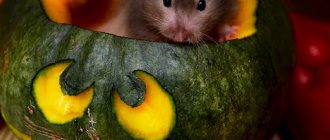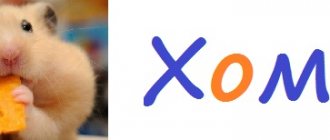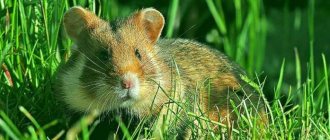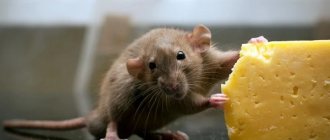- home
- Nutrition
28.03.2018
Can hamsters have apples? This question worries many pet owners. This fruit is common and popular among people, but can you feed it to a hamster? The product is quite suitable as food and contains many useful microelements and vitamins. Below you will find out why apples are useful, what varieties are suitable for food, in what quantity and form they need to be presented to the hamster, and how to introduce the product into the diet.
Vegetables for your hamster
Fresh vegetables are very welcome in the rodent's diet. As a rule, they are given every other day (less often for Campbell hamsters). It is a good source of organic acids, pectin, and other nutrients. They also supply the body with water, which is important for every living creature. Popular foods for hamsters are:
- beets - offered fresh and boiled;
- cucumber (only in season) – dietary, even Campbells are allowed once every 3 days;
- zucchini – useful for water balance, sometimes steamed;
- sweet peppers – without seeds, the peel is removed from the store-bought product;
- carrots - given raw or boiled, Campbells are allowed only tops;
- squash is a dietary vegetable, suitable for all breeds;
- pumpkin is low in calories and very healthy when eaten fresh.
There is a lot of other information about what vegetables can be given to hamsters. So, occasionally you are allowed to pamper your small pet with a piece of radish, turnip, celery, or cauliflower. Boiled without salt or fresh corn is useful; in moderation it is recommended for everyone except the Campbells. Peas and beans are sources of protein.
Article on the topic: Can a hamster have green and black grapes?
Pregnant females
When preparing for breeding, you should know that a pregnant female needs:
- boiled chicken meat;
- boiled yolk;
- skim cheese;
- greens, sprouted grains;
- increased amount of protein food: gammarus, earthworms, grasshoppers, butterflies (necessarily purchased in specialized pet stores).
During the gestation period, the volume of feed is increased so as not to cause concern to the mother due to lack of supplies. A piece of coal, a mineral stone, and calcium gluconate are placed in the cell.
Pregnancy lasts about 20 days. 5-15 babies are born. Fertilization of a female should not be allowed before four months.
It is important to provide the mother with peace: there should be no other hamsters in the cage, it is forbidden to pick up small cubs, because a foreign smell can frighten the mother. It is necessary to provide the female with a balanced diet and ensure peace. All this will prevent manifestations of cannibalism on the part of the mother.
Fruits for your hamster
Hamsters can be given various fruits (with the exception of citrus and exotic ones), but in small doses. The high sugar content makes this complementary food unsafe. Domestic Djungarians are given less of it than individuals of the Syrian breed - within 5% of the main diet. Campbell's hamsters are fed even more carefully.
The main fruit products that are suitable for Syrian and Djungarian hamsters include:
- apple - choose sweet and sour varieties, introduce them from 4 months, do not give to lactating females;
- apricot – a little and not overripe, it is better to give dried apricots out of season;
- peach is better than nectarine, it has less sugar;
- pear – firm yellow or green, uncommon;
- banana – preferably a little greenish, just unripe;
- plum - a little at a time, so as not to provoke diarrhea;
- melon – due to excessive sweetness, allowed only once every 5-7 days;
- watermelon - also rare, but from your own garden (it’s hard to find a store-bought one without nitrates).
Berries will help diversify your diet. Strawberries are offered once every 7 days, a piece with a diameter of 1 cm. The rest of the berries from the list are given 1 piece per week, the portion for the Syrian hamster is doubled. Allowed:
- cherries and sweet cherries (pits removed);
- currant;
- not sour gooseberries;
- grape;
- raspberries;
- blueberry;
- blackberry;
- cowberry;
- blueberry.
Of all of the above, only dietary fruits are suitable for Campbell's hamsters. These are nectarine, blueberry, lingonberry, cherry, hawthorn. It is worth remembering that exotic fruits (mango, avocado, kiwi, pineapple and others) are prohibited from being offered to all rodents. They can cause severe allergic reactions and digestive problems.
What else
As mentioned above, a large number of apples is undesirable. What can replace this delicacy? In nature, there are many types of fruits and berries allowed for hamsters. By combining them, you can profitably diversify and supplement your pet’s diet, replenishing it with new beneficial vitamins and microelements. Allowed to eat: strawberries, currants, cherries, gooseberries, melon, banana, grapes, apricots and peach, pear. Occasionally you can treat your pet to plums, rose hips, raisins, dried apricots, banana and pear chips. The following are strictly prohibited: store-bought chips for rodents (there is no guarantee that they do not contain chemicals), chocolate, cookies, kiwi, watermelon, avocado, fruit and berry seeds.
Dried fruits for hamsters
In winter, instead of not very healthy fresh fruits from the store, it is better to occasionally give your hamster dried fruits, but also in dosed doses. Such treats are often offered as treats and rewards during training. Ideally, of course, prepare them yourself using a special dryer or oven. The raw materials should not be too sweet - apples, pears, viburnum, cranberries, lingonberries.
Article on the topic: Can hamsters have cheese (Djungarian, Syrian and other breeds)
It is worth considering the characteristics of the pet and its predisposition to diabetes. So, in the diet of the Campbell breed they often do without dried fruits; the Djungarian hamster is given less sweet treats, for example, apple slices. Syrian hamster and other species can be given raisins, homemade banana chips and a small piece of prunes 1-2 times a week.
Prohibited Products
Some harmless products can be dangerous for both Syrian and Djungarian hamsters. List of what you should not feed them:
- food intended for parrots or other rodents;
- acorns, chestnuts, potatoes;
- cheese, lard, any products containing more than 3% fat;
- spices;
- almond;
- dairy products;
- sweets, juices;
- fatty food;
- white cabbage is dangerous and fatal;
- garlic, onion;
- chocolate;
- citrus, exotic fruits;
- seeds, seeds of any fruit;
- captured insects that are not typical for the diet of dwarf birds;
- canned, stewed, fried, smoked foods;
- butter.
The Syrian hamster has a lot of positive emotions, joy, laughter, and is not picky about food. But you need to feed him correctly, understanding that his well-being and life expectancy are influenced by proper maintenance, a balanced diet, and tender and kind feelings towards the pet.
Plant food
Fruits in syrup, compote berries, and jam should not be offered to rodents. Any preserved food is prohibited because it contains sugar and salt. Raw seasonal fruits are preferred for feeding. Some of them are placed in the cage boiled (zucchini, beets, carrots, pumpkin). The cooking time in this case is minimal. The water is not salted.
If fresh fruits and vegetables are purchased at the store, it is better to cut off the skin (it often contains pesticides). For home harvest, this step is not necessary. Plant foods, including those from your own garden, must be thoroughly washed. After all, harmful bacteria and helminth eggs may remain on its surface.
All fruits must be fresh, not chapped, and free of rot. The pits of cherries, apples, cherries, plums, and apricots must be removed. The hamster can be poisoned by them. If a pear, pepper or other delicacy is cut into several pieces, the remaining pieces are stored in the refrigerator for several days.
It is important to remember that excessive fruit feeding causes indigestion and increased gas formation in hamsters, and increases the risk of diabetes and obesity. In small quantities, fruits help strengthen the immune system, improve intestinal motility, and are involved in the prevention of many diseases.
Beneficial features
Apple is a low-allergenic fruit. It is good to eat to:
- strengthen the immune system (due to the high content of vitamins);
- maintain a normal cardiovascular system (potassium will help with this);
- increase hemoglobin (this fruit contains a lot of iron);
- improve blood composition (this indicator is affected by copper, zinc and other trace elements).
These familiar fruits also contain a lot of fiber, which has a positive effect on intestinal motility. Rodents should also be fed apples to prevent the development of tumors.
Can hamsters have apples?
Can hamsters have apples? This question worries many pet owners. This fruit is common and popular among people, but can you feed it to a hamster? The product is quite suitable as food and contains many useful microelements and vitamins. Below you will find out why apples are useful, what varieties are suitable for food, in what quantity and form they need to be presented to the hamster, and how to introduce the product into the diet.
Article on the topic: How many times a day should you feed a hamster?
Benefits of banana for rodents
We all know that this fruit is beneficial for the human body, because it contains many microelements necessary for us. But we need to find out how a hamster copes with a banana.
Despite the fact that this fruit does not contain fat, it is very high in calories, as it contains elements such as glucose and fructose in large quantities. This product is able to give the body energy. It contains vitamins C and B6, which are involved in the absorption of iron. Therefore, when a hamster eats a banana, it not only receives useful microelements, but also becomes active and energetic.
Thanks to the phosphorus contained in bananas, your rodent's teeth and bones will become stronger. And the required amount of potassium will improve the functioning of the gastrointestinal tract and heart. These fruits also help strengthen blood vessels, regulate water-salt balance and cleanse the digestive system of accumulated harmful substances. But is it possible to feed a hamster banana? Let's find out.
Bananas at night
Hamsters can eat bananas around the clock because they love them so much. But whether hamsters can have bananas at night is up to you to decide. But still, no matter how much you would like to give him at least a small piece of the fruit, it is better not to do this. Since this fruit charges the body with energy, at night the hamster will be too active: running around the cage, making noise, preventing you from sleeping. If you really want to treat your pet, you can feed him an apple or a pear, he will eat them with pleasure. But it’s better to do this in the evening, and not before bed.
Another reason why it is better not to feed rodents bananas at night is the physiological characteristics of the body. At this time, the digestive system slows down. The animal's stomach will not be ready to eat food, and this can only harm the pet's health.
Heavy food for a hamster
Banana for Djungarian and Syrian hamsters
Djungarian hamsters enjoy eating these overseas fruits. But they are not recommended to abuse these fruits. These animals are prone to high blood sugar levels. Therefore, you should not spoil them with such goodies too often. The interval between eating bananas should be at least a week.
Syrian hamsters also love to eat tasty and sweet food. But for them, one serving of sweets per week is also recommended. The pulp of the fruit should be given in small pieces weighing approximately 5 g. The whole fruit should not be given to animals, because a small hamster and a large banana are not the best combination. The rodent simply cannot eat it at once and will hide the remaining parts of the fruit for storage. The fruit will begin to quickly deteriorate, and if the baby eats it, it can get food poisoning.
Is it possible to feed hamsters apples?
Fruits should not form the basis of a pet's diet. You should not feed your hamster only an apple; the food should be varied and include everything it needs.
The fruit contains almost all types of B vitamins, minerals, calcium, iron, magnesium, phosphorus and potassium, which have a positive effect on the cardiovascular system. The treat will be useful for small hamsters and adults. The product will increase your pet's hemoglobin, renew the blood, improve immunity and intestinal function.
You should not give apples in large quantities because:
- They contain sugar, large amounts of it are harmful. Increasing the level threatens the hamster with diseases, including obesity.
- In addition to the previous point, they contain malic acid, which can disrupt the functioning of the gastrointestinal tract.
- If you cut it into small pieces, the animal can hide some of it. Then the remains will begin to rot, the process will spread to other products, which will cause poisoning in the animal.
There are features of introducing fruits into the diet. The owner must pay close attention to the amount of product. There should not be too many of them; it is impossible to replace the main diet of a rodent with fruits alone. There are certain groups of animals for which this product is prohibited; consumption may lead to bad consequences. These include young animals up to one month old, elderly and pregnant animals.
Features of introduction into the diet
A hamster can only eat a ripe apple, because an unripe fruit will cause diarrhea. The age and condition of the animal also matters - pregnant females, babies (up to 1 month), as well as elderly individuals should not be given such fruits. These hamsters will not be able to digest large amounts of fiber and will suffer from indigestion.
In winter, instead of feeding the animal not very healthy fruits bought in the supermarket, it is better to give it dried apples. Fruits of local varieties collected from your own apple tree or purchased in the fall should be prepared in advance. Such complementary foods will be much healthier than fresh fruits treated with preservatives.
Choosing a variety
Which variety to choose for dzungaria and do you need to process the fruits? There is no need to choose varieties that are too sweet; your pet will like them, but they can be harmful to health. Too sour fruits are also not suitable; ripe, moderate-tasting fruits are best. If you choose a fruit that is not ripe enough, the animal may have digestive problems.
Regarding processing, the rules are:
- Store-bought apples must be peeled; the fruits may be treated with chemicals. This condition especially applies to fruits purchased in winter. In cold weather, it is better not to buy them for your pet.
- Homemade fruits must be washed.
- Dried apples are better for winter. Soak them in water before giving them to your hamster.
- Fruits must be washed thoroughly under running water.
Article on the topic: Types and breeds of chinchillas with photographs and names of different colors
Reasons for banning pomegranate
First you need to figure out what it is. Pomegranate is an exotic fruit that contains calcium, vitamins, iron, phosphorus, and magnesium. For humans this is a treasure trove of useful substances, but for a hamster the product is dangerous.
The body cannot cope with the acidity contained in the fruit and can cause severe stomach pain. A large amount of vitamins also leads to hypervitaminosis, and bones can damage an already weak digestive system. You should not give pomegranate bark, so that your pet does not suffer from severe constipation. Pomegranate seeds contain fat, which adversely affects the functioning of the animal’s liver, and the essential oils of the fruit cause an allergy attack.
Apples for dwarf and Syrian hamsters
The health of Djungarian and Syrian hamsters is no different from others. You should not give a large amount of treats to your Syrian hamster at once; first you need to check whether the body reacts normally to the new product. To do this, you need to give a small piece for the first time and see the reaction. If there are no deviations, you can gradually increase the amount of treats. Follow the rules and give apples to Djungarian and Syrian hamsters in moderation.
Hamsters can be given apples with the peel if they are grown in your own garden. In all other cases, it is better to cut it off.
- Treats will not replace your pet's main food.
- You can't give too much.
- It is better to feed the animal with homemade fruits, having previously processed them.
- Choose sweet and sour varieties.
- Fruits can be used by all breeds of rodents, but should be given with caution. Check whether the product is suitable for a particular individual.
Why you shouldn't give too much
The idea of whether to feed a hamster an apple is no longer in doubt - these fruits should be in their diet. If used in moderation, no substances were found in them that could be harmful. Therefore, it is necessary to adhere to the advice recommended by veterinarians. The product must be fresh and not treated with harmful chemicals. It is best if the apples are from your own garden or purchased at the market from trusted sellers. Stores sell fruits with special mixtures applied to them so that they do not spoil or wither. This product will not be beneficial for your pet. “Wormy” fruits are considered especially clean.
It is necessary to give a small amount and no more often than every one or two days. This is not the main food, but rather serves as a dessert or complementary food. His main diet consists of special grain mixtures.
Excessive consumption of fruits can cause increased gas formation, stomach problems, excess weight, and even increased blood sugar levels.
Don't forget that fruit spoils soon. Make sure that the leftovers do not end up among the animal’s main food and that rotting does not begin, which will have a detrimental effect on the small organism and on its other food products. Check periodically to see if he has buried pieces “in reserve” somewhere in his house.
Interesting Facts
Djungarian hamsters were domesticated only in the middle of the twentieth century. Rodents of this breed feel comfortable in an apartment and get along well with people.
A few facts will help you better understand these animals:
- Rodents' teeth grow throughout their lives, so they need mineral stones to grind them down. Too large incisors can damage the animal's delicate cheeks.
- Rodents of this breed do not hibernate in winter, but in severe frosts they become numb for several hours. This condition may mean that the animal is stressed or lacking oxygen.
- At temperatures below +16°C, hamsters shed. In winter, their gray color becomes lighter.
- They are capable of traveling several tens of kilometers during the night. In the wild, hamsters divide territory and, if invaded, fiercely defend their home, so it is not worth putting 2 animals in a cage. They do well alone.
- Pregnancy in these rodents lasts for 25 days. From 1 to 11 cubs are born.
- The Djungarian hamster is a dwarf breed, individuals reach 10 cm in length and weigh from 30 to 65 g. The animals are distinguished by smooth fur and a dark stripe along the body, which most individuals have.
- Rodents of this breed quickly get used to humans, but taming should be gradual.
Nutrition of sick, weakened and elderly animals
As a hamster ages, its teeth begin to deteriorate, and therefore it eats much less actively. Therefore, the diet of such an animal should be dominated by pureed vegetables, ground nuts and food. It is also possible to use baby porridge without milk. But in order to avoid intestinal upset, one should not give up grain feed, which should still be the main one in the rodent’s menu.
In addition, porridge can be used to add vitamins and medicines to support and treat weakened and sick animals. However, a jar of such food cannot be stored in the refrigerator for more than two days.
Warm brewed chamomile is often used to drink sick children. It should be prepared twice a day. But giving honey or milk to a sick animal is strictly prohibited . If the animal does not want to eat, it must be force-fed. Without food he will not be able to get better. In addition, prolonged starvation can lead to the death of the rodent.
For feeding in case of illness, syringes without a needle are often used. In this case, the owner should hold the pet at an angle in one hand and a syringe in the other. In this situation, porridge for small children would be perfect. You can also grind the food and mix it with water. When feeding weakened or sick animals, it is important to be extremely careful so that they do not choke on food or water.
Well, at least a little...
You can try a drop. Moreover, 1 drop of juice is exactly one drop. Not more. In winter, the amount of vitamin C in the hamster’s body decreases. Fresh grass and vegetables are more difficult to get than in summer. But pomegranate is always full of these vitamins. Even in winter. If you have decided, at any cost, to expand your pet’s diet and provide him with vitamin supplements, here is one piece of advice:
Experts suggest diluting 2 drops of juice in half a glass of clean water. Just don’t give all this half a glass to the hamster at once. Let him drink plain water. This way you can compensate for the lack of vitamins in your hamster.
All processes occurring in the hamster’s body occur very quickly, including diseases. In order for your pet to be healthy and cheerful, it is necessary to exclude this fruit, which is healthy for humans, from the list of food products. By taking care of your hamster and following the recommendations, you can increase its lifespan.
Choosing dry food
Instead of self-composed grain mixtures, you should prefer ready-made industrial food produced under brands specializing in food for rodents. Their composition includes the amount of nutrients, mineral and vitamin supplements necessary to maintain the health of the hamster. In addition to the traditional components of dry food, the composition of some immediately includes dried vegetables, dried fruits and other elements of a balanced diet.
For your pet, you need to purchase high-quality food produced by trusted companies. If possible, you should avoid cheap feeds that are classified as economy-class products. It is best to buy food intended specifically for Djungarian hamsters, since mixtures for other varieties may contain prohibited components that will have to be pre-selected manually.
Dry food takes up 80-90% of a hamster's daily diet. At the same time, the daily food requirement for a fluffy is one tablespoon. Despite all the gluttony of a rodent, its proper, complete feeding does not require large expenses.
Well, at least a little...
You can try a drop. Moreover, 1 drop of juice is exactly one drop. Not more. In winter, the amount of vitamin C in the hamster’s body decreases. Fresh grass and vegetables are more difficult to get than in summer. But pomegranate is always full of these vitamins. Even in winter. If you have decided, at any cost, to expand your pet’s diet and provide him with vitamin supplements, here is one piece of advice:
Experts suggest diluting 2 drops of juice in half a glass of clean water. Just don’t give all this half a glass to the hamster at once. Let him drink plain water. This way you can compensate for the lack of vitamins in your hamster.
All processes occurring in the hamster’s body occur very quickly, including diseases. In order for your pet to be healthy and cheerful, it is necessary to exclude this fruit, which is healthy for humans, from the list of food products. By taking care of your hamster and following the recommendations, you can increase its lifespan.
